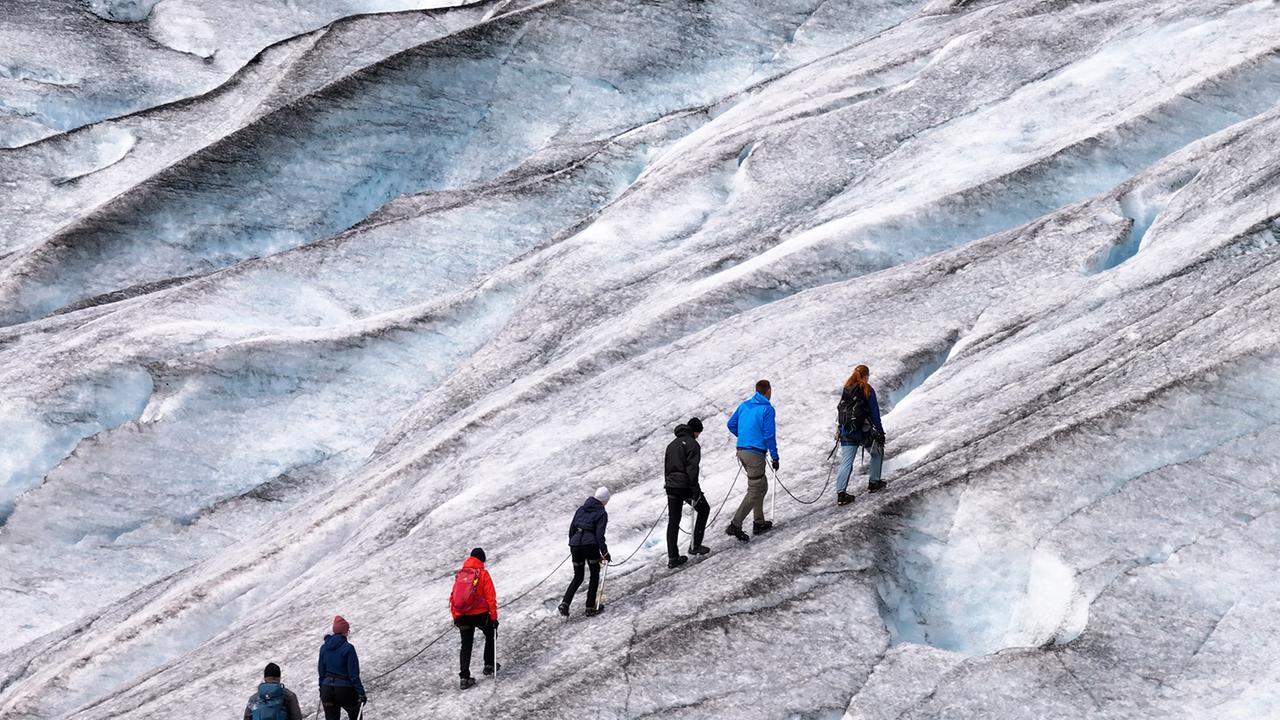report
According to an EU study, cooler holiday regions in Europe could benefit permanently from climate change in the future. Scandinavian countries have already begun to focus their tourism advertising on this.
With ice axes and crampons in single file: This is how a group of tourists struggles up the Norwegian glacier Nigardsbreen. The view down into the valley: deep green water in the glacier lake, countless waterfalls on rugged rock faces. The wind is cool, with a temperature of just under ten degrees, but the high altitude sun warms their faces.
For Hanneke Bechthum from the Netherlands, it was a perfect day on her summer vacation. She says: “Of course, most people still want to be in the sun. But Spain or Italy at this time of year? It's getting hotter and hotter there and to be honest, I can't stand it there anymore.”
This means that Bechthum, who booked the glacier hike with a friend and her two sons, is part of a steadily growing group of holidaymakers. Tour guide Steinar Bruheim has been taking tourists to the Nigardsbreen glacier for more than 40 years. He has found his own term for holidaymakers like Hanneke Bechthum: “We call them 'climate tourists' because they are fleeing the heat of southern Europe. That's why they come to us in Scandinavia in the summer. Even though we may only have 15 degrees here and quite a lot of rain.”
Massive increase in Tourist numbers
This development is not only being observed at Nigardsbreen in Norway. The number of holidaymakers from abroad who prefer the temperate summer in Scandinavia is also growing at Swedish campsites. Among them are Karin and Janek Struwe from Brandenburg, who are stopping off for a short time at the Säter campsite three hours north-west of Stockholm in their camper van.
In the past, they also spent their summer holidays as a family on the Mediterranean. Now it's too hot for them there, as Karin Struwe reports: “It's disgustingly hot. You can't do anything, you're always wearing a hat, you're always putting on sunscreen. It's just no fun.” Things are completely different in Säter today. It's 19 degrees, and heavy rain showers pass over the square every now and then.
Campsite operator Bert de Vries reports a 20 percent increase in foreign guests so far this year. “We ask our guests: 'Is this your first time in Sweden?' Many say: 'Yes. We used to travel south. But now it's hot or there are floods.' That's why more and more people are choosing Scandinavia,” reports de Vries, who is quite pleased with the development.
Fascinating – and pleasantly cool: Norway's glaciers are attracting more and more tourists.
Cool weather as a marketing factor
Under the slogan “Coolcation” – based on the English word “vacation” – the Swedish state tourism agency “Visit Sweden” has started to market the trend. Company boss Susanne Andersson says: “We have highlighted on our websites what you can experience in Sweden to appeal to customers who are interested in “Coolcation” holidays. And that has led to us being very, very high up in international searches for “Coolcation”. Sweden is now number one there.”
Not everyone in the country is happy with this. Popular regions are already suffering from the effects of mass tourism, especially in the summer months. In Sweden, there is also a debate about whether the country should be allowed to profit from climate change in this way.
According to a study by the European Union, this development could become a steady trend in the coming years. The effects of current climatic conditions on tourist flows were evaluated using data from 269 European regions. The conclusion of the study: “We see a clear north-south pattern in the changes in tourism demand. The northern regions are benefiting from climate change, while the southern regions are facing significant declines in tourism demand,” the study states.
Tour guide Steinar Bruheim doesn't want any more advertising in Asia. Because the further people travel, the more damage they do to the glacier they want to see.
“It's paradoxical”
At the glacier in Norway, mountain guide Bruheim points to the exposed rock ridges below the glacier. “Twenty years ago, the glacier stretched far down into the valley,” Bruheim remembers. He warns of the consequences of unchecked tourism. “We told the tourism industry in Norway: 'Stop marketing in Asia!' Because it's a paradox: They want to see the glaciers before they disappear. But if more and more people come by plane, the impact on climate change will increase. And with it the threat to the glacier.”
The “coolcation” does not yet seem to be a mass trend; nevertheless, the consequences of climate change for tourism in Europe are already becoming apparent in Scandinavia. And these are likely to become even more pronounced in the coming years, especially in summer.
ARD Stockholm, daily news, 02.08.2024 16:37




